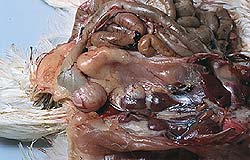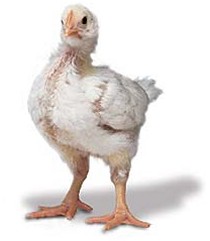Pathogenesis
Virus kinetics
Chickens are the only hosts known to develop clinical disease and distinct lesions following exposure to IBDV. The most likely route of infection is oral ingestion of contaminated faeces or other contaminated organic material. Using immunofluorescence techniques Weiss et al (1994) demonstrated that following oral infection:
- Virus was present within 4-5 hours in the macrophages and lymphatic cells of the duodenum, jejunum and caecum.
- Duodenum, jejunum and caecum are the first sites of viral replication.
- By way of the portal venous system virus reaches the liver within 5 hours post infection.
- Kupffer cells in the liver trap and phagocytose a considerable amount of virus particles.
- IBDV reaching the main bloodstream is circulated to other organs including the bursa of Fabricius.
- Immature B-lymphocytes in the follicles of the bursa are the target cells for viral replication.
- By 13 hours post-infection most follicles in the bursa are virus positive.
- By 16 hours post infection a second massive viraemia occurs.
- There is infection and secondary viral replication in other lymphatic organs.
- Clinical disease and death occurs within 64-72 hrs post-infection.

Enlarged and covered in gelatinous exudate.

Summary of Pathology
Chickens showed no IBDV symptoms when the bursa of Fabricius was surgically removed prior to IBDV infection. Clinical IBDV symptoms manifest in a narrow age range of 2 to 8 weeks (exceptions of 10 days to 20 weeks of age), coinciding with the age at which the bursa of Fabricius is populated with the highest concentration of immature B-lymphocytes. Clinical symptoms do not manifest when chickens are infected earlier than about two weeks of age, however bursal pathology is still evident.
Severe bursal pathology during the first two weeks post hatch (refer Variant IBDV) results in severe immunosuppression. The kinetics of virus multiplication is similar for all IBDV pathotypes, with the exception that the more virulent the strain the higher the amplification of viral replication at each step, with resultant increased severity in clinical symptoms.

Peer Reviewed by Dr J J (Sjaak) de Wit and William Baxendale.

Chickens are the only hosts known to develop clinical disease and distinct lesions following exposure to IBDV.
